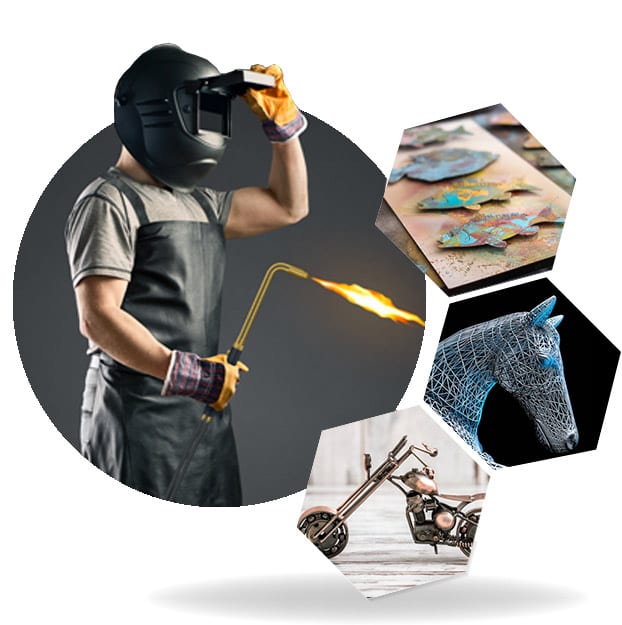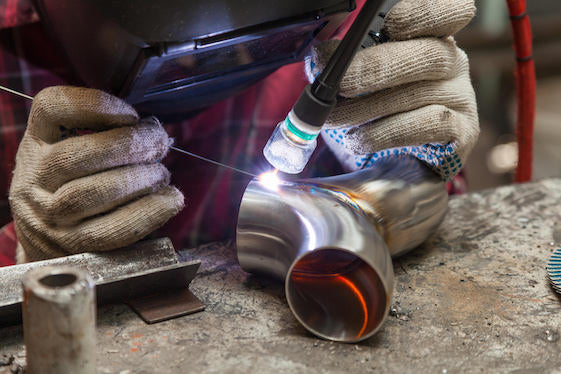Usual Welding Repair Work Issues and How to Address Them Efficiently
Welding fixings commonly come across a series of concerns that can endanger the honesty of the final item. Common problems include insufficient penetration, porosity, and misalignment, among others. Each issue presents one-of-a-kind challenges that call for particular strategies for resolution. Understanding these concerns is necessary for welders intending to improve their results and skills. This discussion will certainly explore these usual welding repair service concerns and efficient methods to resolve them.
Poor Penetration
Insufficient infiltration takes place when the weld metal falls short to completely fuse with the base material, causing weak joints and prospective architectural failings. This problem frequently stems from insufficient warm input, inaccurate electrode angle, or inappropriate welding speed. Welders might come across insufficient infiltration as a result of a miscalculation of the necessary parameters for a particular product density or type. Furthermore, contamination on the base material's surface area can prevent reliable bonding, worsening the issue. To attend to poor infiltration, welders should assure ideal settings on their devices and maintain a clean job surface area. Regular evaluation of welds is suggested to recognize any type of deficiencies early, permitting timely adjustments and the prevention of jeopardized structural integrity in welded settings up.
Porosity
Porosity is an usual defect in bonded joints that shows up as tiny gas bubbles caught within the weld metal. This issue can compromise the honesty of the weld, bring about reduced stamina and potential failing under stress and anxiety. Montana Mobile Welding and Repair. Porosity commonly emerges from contamination, dampness, or incorrect welding strategies, which enable gases to run away into the molten weld pool. To attend to porosity, welders should ensure correct surface prep work, keep a tidy workplace, and utilize suitable welding parameters. Additionally, choosing the best filler material and shielding gas can minimize gas entrapment. Regular inspection and testing of welds can assist determine porosity early, guaranteeing prompt restorative actions are taken, thereby maintaining the high quality and integrity of the welded framework
Imbalance
Misalignment in welding can arise from numerous aspects, consisting of inappropriate arrangement and thermal development. Understanding the origin is important for reliable resolution. A number of adjustment strategies are available to realign parts and guarantee structural stability.
Reasons for Imbalance
Welding misalignment usually stems from a selection of underlying issues that can compromise structural honesty. One main cause is improper fit-up of components prior to welding, which can lead to gaps and unequal surface areas. Variants in thermal expansion throughout the welding process can likewise result in distortion, especially if the products being joined have various coefficients of growth. In addition, insufficient fixturing and securing might stop working to hold elements firmly in position, causing movement during welding. Improperly kept devices, consisting of welding makers and tools, might introduce inconsistencies in the weld grain, additional adding to misalignment. Driver error, stemming from inadequate training or experience, can also play a substantial duty in developing misaligned welds.

Adjustment Methods Available
Attending to misalignment properly calls for a mix of restorative methods customized to the particular problems available. One typical approach is using fixtures or jigs to hold components in the correct setting during welding, making sure regular positioning. Additionally, preheating the products can help in reducing distortion and improve fit-up. For considerable imbalance, mechanical realignment strategies, such as using hydraulic jacks or clamps, can be used to correct the setting before welding. Post-weld warmth treatment may additionally be required to alleviate stresses caused by misalignment. Cautious assessment and change during the setup phase can stop misalignment issues from ending up being considerable troubles, advertising a smoother welding process and boosting total architectural stability.
Distortion
Distortion is an usual challenge in welding that can occur from various factors, including uneven heating and air conditioning. Comprehending the root causes of distortion is important for executing effective avoidance techniques. Resolving this problem not only improves architectural honesty however likewise enhances the general quality of the weld.
Causes of Distortion
When based on the extreme warm of welding, products frequently undergo modifications that can cause distortion. This sensation largely occurs from thermal growth and tightening throughout the welding process. As the weld location heats up, the material increases; upon cooling, it acquires, which can produce inner stress and anxieties. On top of that, unequal heating across a workpiece can aggravate these anxieties, leading to bending or flexing. The sort of product also plays a considerable role; metals with varying thermal conductivity and coefficients of growth may respond in different ways, leading to uncertain distortions. Moreover, inadequate joint layout and poor fixturing can add to imbalance throughout welding, enhancing the possibility of distortion. Understanding these reasons is important for reliable welding repair service and avoidance techniques.
Avoidance Techniques
Effective avoidance techniques for distortion during welding concentrate on controlling heat input and making certain correct joint style. Maintaining a regular warmth input aids to lessen thermal growth and tightening, which can cause distortion. Utilizing strategies such as preheating the work surface can additionally decrease the temperature level slope, promoting uniform heating. In addition, selecting proper joint layouts, such as T-joints or lap joints, can enhance security and minimize anxiety focus. Executing correct fixturing to secure the work surfaces in position even more aids in maintaining positioning throughout the welding process. Finally, staggered welding sequences can disperse heat more equally, stopping local distortion. By applying these methods, welders can greatly lower the chance of distortion and improve the total quality of their welds.
Breaking
Breaking is a typical concern experienced in welding repair services, often resulting from numerous factors such as incorrect air conditioning prices, material choice, or poor joint prep work. The incident of fractures can substantially jeopardize the honesty of the weld, resulting in prospective failures throughout procedure. To address this issue, welders must initially analyze the origin triggers, guaranteeing that materials are suitable and properly chosen for the specific application. Furthermore, regulating the air conditioning price during the welding procedure is crucial; fast cooling can cause tension and result in splitting. Proper joint layout and prep work likewise add to reducing the danger. Implementing these methods can improve weld high quality and durability, eventually reducing the likelihood of breaking in completed weldments.

Incomplete Fusion
A substantial problem in welding repairs is insufficient blend, which takes place when the weld metal does not effectively bond with the base product or previous weld passes - Montana Mobile Welding and Repair Belgrade Fabrication. This defect can bring about weaknesses in the joint, potentially jeopardizing the integrity of the bonded framework. Elements adding to insufficient fusion include insufficient warm input, inappropriate welding technique, and contamination of the surface areas being signed up with. To resolve this concern successfully, welders must guarantee appropriate pre-weld cleaning and surface preparation, as well as adjust their welding criteria to achieve sufficient infiltration and blend. Normal inspection throughout the welding procedure can additionally help recognize incomplete combination early, allowing for timely restorative actions to improve the overall high quality of the weld
Overheating
While welding repair services can improve architectural integrity, overheating offers a significant difficulty that can cause product destruction. Too much heat throughout welding can alter the mechanical buildings of metals, causing decreased toughness, raised brittleness, and bending. This sensation is specifically critical in high-stress applications where structural dependability is extremely important. Determining overheating can include aesthetic assessments for discoloration or distortion, in addition to monitoring temperature during the inverter mig welder welding process. To minimize the dangers linked with getting too hot, welders ought to employ proper methods, such as regulating heat input, readjusting traveling rate, and making use of ideal filler products. In addition, executing pre- and post-weld warm treatments can assist restore material properties and enhance the total top quality of the repair service, making certain lasting performance and safety and security.
Frequently Asked Inquiries
What Are the Typical Signs of a Welding Defect?

Exactly How Can I Check My Welds for High quality?
To test welds for top quality, one can use visual examinations, ultrasonic testing, and radiographic methods. Each method assures architectural integrity, identifies defects, and validates adherence to specified requirements, inevitably boosting the dependability of the bonded joints.
What Safety Preventative Measures Should I Take While Welding?
When welding, one need to focus on security by wearing ideal personal safety tools, ensuring correct air flow, safeguarding flammable materials away, preserving a clean workspace, and recognizing environments to stop injuries and accidents.
Can I Fix a Weld Without Redoing the Entire Joint?
Fixing a weld without remodeling the whole joint is possible, relying on the damage (Montana Mobile Welding and Repair Welding). Techniques such as grinding, adding filler product, or utilizing a welding procedure can successfully deal with particular problems while preserving the surrounding framework
What Equipment Are Necessary for Effective Welding Repair Works?
Crucial devices for reliable welding repair services include a welding device, cable brush, mill, safety gear, clamps, and filler products. Each tool plays a vital function in guaranteeing high quality and safety during the fixing process. Porosity generally emerges from contamination, moisture, or inappropriate welding methods, which allow gases to get away right into the molten weld pool. Poorly conserved devices, mag welding consisting of welding equipments and devices, may present incongruities in the weld grain, further contributing to imbalance. When subjected to the extreme warm of welding, materials frequently undertake changes that can lead to distortion. Cracking is a common problem come across in welding repairs, often resulting from different aspects such as improper air conditioning rates, material option, or poor joint preparation. A significant issue in welding repairs is insufficient combination, which takes place when the weld steel does not adequately bond with the base material or previous weld passes.